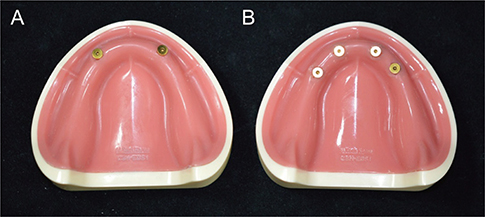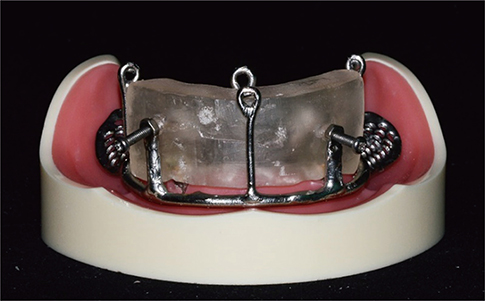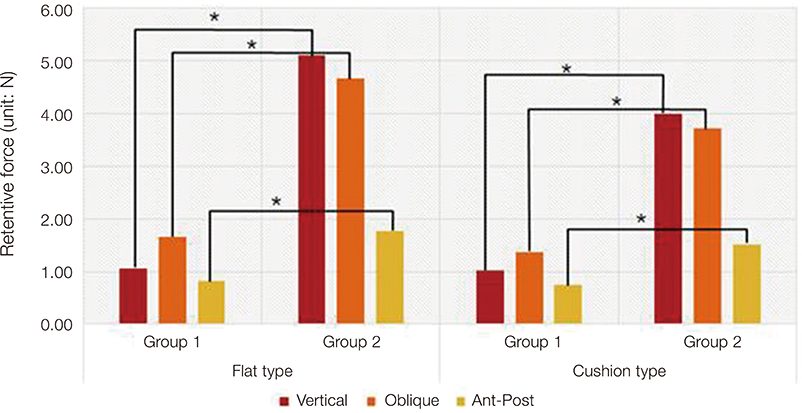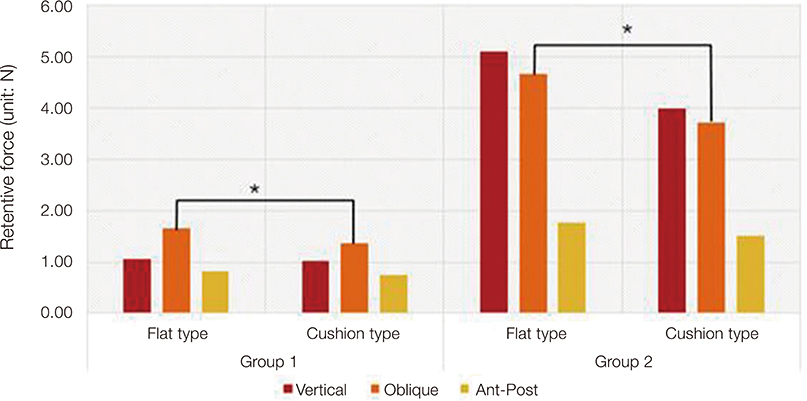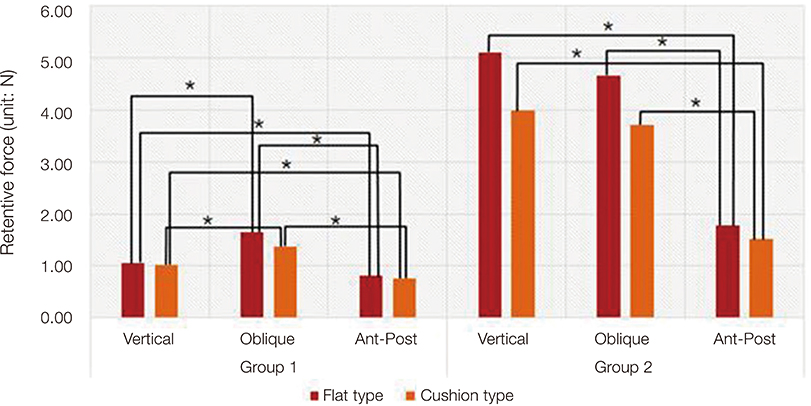J Adv Prosthodont.
2017 Feb;9(1):14-21. 10.4047/jap.2017.9.1.14.
The influence of the number and the type of magnetic attachment on the retention of mandibular mini implant overdenture
- Affiliations
-
- 1Department of Prosthodontics, College of Dentistry, Dankook University, Cheonan, Republic of Korea. syshin@dankook.ac.kr
- KMID: 2368207
- DOI: http://doi.org/10.4047/jap.2017.9.1.14
Abstract
- PURPOSE
The aim of this study was to compare the retention of mini implant overdenture by the number, the type of magnetic attachment, and the directions of applied dislodging force.
MATERIALS AND METHODS
The experimental groups were designed by the number and type of magnetic attachment. Twenty samples were tested with Magden implants. Each attachment was composed of the magnet assembly in overdenture sample and the abutment keeper in a mandibular model. Dislodging forces were applied to the overdenture samples (50.0 mm/min) in 3 directions. The loading was repeated 10 times in each direction. The values of dislodging force were analyzed statistically using SPSS at 95% level of confidence.
RESULTS
The retentive force of group 2 was greater than that of group 1 in both types of attachment in every direction (P < .05). Oblique retentive force of flat type magnetic attachment was higher than that of cushion type attachment in both groups (P < .05). In group 1, oblique retentive force showed the highest and anterior-posterior retentive force showed the lowest value in both attachment types (P < .05). In group 2, both types of attachment showed the lowest retentive force with anteriorposterior direction of dislodging force (P <.05).
CONCLUSION
Proper retentive properties for implant overdenture were obtained, regardless of the number and type of magnetic attachment. In both types of magnetic attachment, the greater retentive force was attained with more implants. Oblique retentive force of flat type magnetic attachment was greater than that of cushion type. Among all subgroups, anterior-posterior retentive force was the lowest among three different directions of dislodging force.
MeSH Terms
Figure
Cited by 1 articles
-
Effects of type of magnet attachment and implant angulation in two implant overdenture models
So-Yeon Song, Kyeong-Hwan Kang, Jeong-Yol Lee, Sang-Wan Shin
J Adv Prosthodont. 2020;12(1):33-37. doi: 10.4047/jap.2020.12.1.33.
Reference
-
1. Burns DR, Unger JW, Elswick RK Jr, Giglio JA. Prospective clinical evaluation of mandibular implant overdentures: Part II--Patient satisfaction and preference. J Prosthet Dent. 1995; 73:364–369.2. Gunne HS, Bergman B, Enbom L, Högström J. Masticatory efficiency of complete denture patients. A clinical examination of potential changes at the transition from old to new denture. Acta Odontol Scand. 1982; 40:289–297.3. Tarbet WJ, Boone M, Schmidt NF. Effect of a denture adhesive on complete denture dislodgement during mastication. J Prosthet Dent. 1980; 44:374–378.4. Burns DR, Unger JW, Elswick RK Jr, Beck DA. Prospective clinical evaluation of mandibular implant overdentures: Part I-Retention, stability, and tissue response. J Prosthet Dent. 1995; 73:354–363.5. Seo M, Cho IH. A comparative study on the retention of implant overdenture according to the shape and the number of magnetic attachment. MS Thesis. Department of prosthodontics, Colleges of Dentistry, Dankook University;2007.6. Mensor MC. Removable partial overdentures with mechanical (precision) attachments. Dent Clin North Am. 1990; 34:669–681.7. Cune MS, de Putter C, Hoogstraten J. Treatment outcome with implant-retained overdentures: Part II--Patient satisfaction and predictability of subjective treatment outcome. J Prosthet Dent. 1994; 72:152–158.8. Engquist B, Bergendal T, Kallus T, Linden U. A retrospective multicenter evaluation of osseointegrated implants supporting overdentures. Int J Oral Maxillofac Implants. 1988; 3:129–134.9. Gendusa NJ. Magnetically retained overlay dentures. Quintessence Int. 1988; 19:265–271.10. Behrman SJ. The implantation of magnets in the jaw to aid denture retention. J Prosthet Dent. 1960; 10:807–841.11. Schmitz JF. Measurement of the efficiency of the platinumcobalt magnetic implant. J Prosthet Dent. 1966; 16:1151–1158.12. Connor RJ, Svare CW. Proplast-coated high-strength magnets as potential denture stabilization devices. J Prosthet Dent. 1977; 37:339–343.13. Freedman H. Magnets to stabilize dentures. J Am Dent Assoc. 1953; 47:288–297.14. Sagawa M, Fujimura S, Togawa M, Yamamoto H, Matsuura Y. New material for permanent magnets on a base of Nd and Fe. J Appl Phys. 1984; 55:2083–2087.15. Strnat KJ. The hard-magnetic properties of rare earth-transition metal alloys. IEEE Trans Magnet. 1972; 8:511–516.16. Highton R, Caputo AA, Kinni M, Matyas J. The interaction of a magnetically retained denture with osseointegrated implants. J Prosthet Dent. 1988; 60:486–490.17. Walmsley AD, Brady CL, Smith PL, Frame JW. Magnet retained overdentures using the Astra dental implant system. Br Dent J. 1993; 174:399–404.18. Walmsley AD. Magnetic retention in prosthetic dentistry. Dent Update. 2002; 29:428–433.19. Flanagan D, Mascolo A. The mini dental implant in fixed and removable prosthetics: a review. J Oral Implantol. 2011; 37:123–132.20. Tu CY, Lin LD, Wang TM, Hsu YC, Lee MS. Using mini dental implants to improve the stability of an existing mandibular complete denture in a patient with severe ridge resorption. J Prost Impl. 2012; 1:48–52.21. Morneburg TR, Pröschel PA. Success rates of microimplants in edentulous patients with residual ridge resorption. Int J Oral Maxillofac Implants. 2008; 23:270–276.22. Gillings BR. Magnetic retention for complete and partial overdentures. Part I. J Prosthet Dent. 1981; 45:484–491.23. Riley MA, Walmsley AD, Harris IR. Magnets in prosthetic dentistry. J Prosthet Dent. 2001; 86:137–142.24. Jonkman RE, Van Waas MA, Kalk W. Satisfaction with complete immediate dentures and complete immediate overdentures. A 1 year survey. J Oral Rehabil. 1995; 22:791–796.25. Gillings BR. Magnetic denture retention systems: inexpensive and efficient. Int Dent J. 1984; 34:184–197.26. Prieskel HW. Precision attachments in prosthodontics. 2nd ed. Chicago; IL: USA Quintessence book;1986. p. 191–241.27. Lewandowski JA, White KC, Moore D, Johnson C. An investigation of two rare earth magnetic systems by measuring grip force and reseating force. J Prosthet Dent. 1988; 60:705–711.28. Akaltan F, Can G. Retentive characteristics of different dental magnetic systems. J Prosthet Dent. 1995; 74:422–427.29. Sarnat AE. The efficiency of cobalt samarium (Co5Sm) magnets as retention units for overdentures. J Dent. 1983; 11:324–333.30. Ma PS, Shin SW. Three-demensional finite element analysis on the mandibular implant-supported overdentures depending upon the type of magnetic attachments and number of fixtures. MS Thesis. Department of prosthodontics, Graduate School of Clinical Dentistry, Korea University;2005.31. Thompson IM. Magnetism as an aid to a prosthetic problem. Br J Oral Surg. 1964; 2:44–46.32. Gillings BR. Magnetic retention for dentures. Dent Outlook. 1983; 9:1–9.33. Lim HW, Cho IH. A study on the changes in magnetic force of magnetic attachments for overdenture. MS Thesis. Department of Prosthodontics, College of Dentistry, Dankook University;2014.
- Full Text Links
- Actions
-
Cited
- CITED
-
- Close
- Share
- Similar articles
-
- Mandibular implant-natural tooth retained overdenture using magnetic attachment with stress breaker
- Mandibular implant overdenture using Locator R-Tx attachment: A case report
- Implant overdenture treatment using several solitary attachment systems on mandibular edentulous patients
- Effects Of Overdenture Retention On The Axial Load Of Implant In The Mandibular Implant-Supported Overdenture
- A THREE DIMENSIONAL PHOTOELASTIC STRESS ANALYSIS OF OMPLANT-SUPPORTED MANDIBULAR OVERDENTURE ACCORDING TO IMPLANT NUMBER AND ATTACHMENT TYPE

